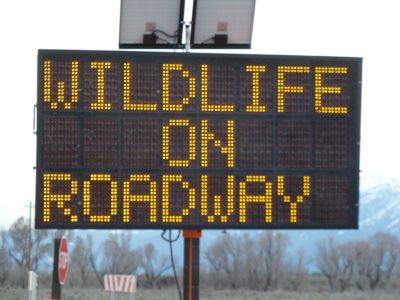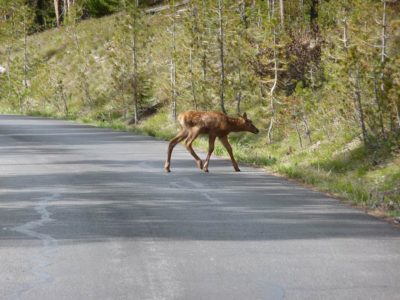This article originally appeared in the 2016 March/April issue of Escapees Magazine.
After spending a few months in an overcrowded section of the country, Chuck and I were relieved to once again drive the open roads of the West recently, admiring the vistas and grandeur along the way. With no other vehicles in sight and feeling like I owned the road, I relaxed at the wheel and clicked on cruise control.
Suddenly, a small herd of deer bounded in front of us. My reverie switched to alarm and then to alert. How many warning signs had I missed? How many more deer were poised to cross the road?
Pay Attention
“Pay attention to wildlife crossing signs!” says Mary Ann Bonnell, Ranger One with Jefferson County Open Space in Colorado. “A lot of highway departments work to provide safe crossings. They research where animals cross and what makes them want to cross there.”
Fences draw animals to certain points, according to Mary Ann, and create concentrated animal crossings. “Pay attention to different speed limits,” she says. “Too many people feel like ‘Whatever……’”
It has been estimated that a million furry, feathered, and scaly animals a day become roadkill in the United States. Animals are attracted to road surfaces for other reasons than merely crossing. Many are attracted by salt and gravel. Snakes are attracted by heat. Some animals are attracted by fruit trees in medians. And roadkill can have collateral damage as crows, coyotes, and other scavengers are attracted by roadkill carcasses.
Don’t Swerve
Some drivers swerve to avoid small animals darting onto the road. “Motorists have caused serious accidents by trying to swerve or stop to avoid a squirrel in the road,” reports Wikipedia. “Such evasive maneuvers are pointless, since small rodents and birds are much more agile and have much quicker reaction times than motorists in heavy vehicles.” Most human fatalities in animal-related crashes, according to Good2Go Auto Insurance, are caused by drivers swerving to miss the animal and then hitting other objects.
Large Animal Collisions
But while striking a small animal may not inflict injury other than to the animal itself, colliding with large animals can.
“According to the National Highway Traffic Safety Administration,” reports car-accidents.com, “there are about 1.5 million car accidents with deer each year that result in $1 billion in vehicle damage, about 150 human fatalities, and over 10,000 personal injuries.” And those are just the statistics from reported incidents.
The Jackson Hole Wildlife Foundation reports an average of 300 elk, deer, and moose are killed on Teton County roads in Wyoming each year, not to mention smaller animals that lose their lives to traffic. “Everything from grizzly to elk to moose to eagles to snakes to squirrels to marmots is killed every year,” says Cory Hatch, Executive Director of the Wildlife Foundation.

In an attempt to save wildlife and spare motorists the costs and injuries of collisions with wildlife, the Jackson Hole Wildlife Foundation created the program Give Wildlife a Brake ™. Part of the program involves placing portable electronic message signs that display various messages along roadsides to alert drivers of wildlife hotspots. “This tool can change human behavior by alerting drivers of wildlife hazards,” according to the Wildlife Foundation website. “Informing a driver of a hazard improves their reaction time, giving them a significantly better chance of avoiding a wildlife collision.”
Besides paying attention to various warning signs, however, drivers must remain alert for wildlife on or near the roads at all times. “In particular,” says Cory Hatch, “look out for animals early in the morning and in the evening. Slow down and keep an eye on the sides of the road.”
Any large animal can inflict damage and injury. “If you hit a moose,” says Mary Ann Bonnell, “it’s coming through your windshield because they are so tall.”
For the Sake of Wildlife
While no other deer crossed in front of us on our drive through desolate western roads, those that bounded in front of us reminded us to maintain our guard, watch for wildlife crossing signs, and scan roadsides along the way. Now for our sake, for our vehicle’s sake, and, especially, for the sake of wildlife, we will be more aware of animals on or near the road as we continue our RV lifestyle.
To avoid injury and vehicle damage, and for the sake of wildlife, follow driving tips offered by the Jackson Hole Wildlife Foundation (http://jhwildlife.org/):
- Expect wildlife on our roads.
- If you encounter an animal on a road with high snow banks, allow the animals to move down the road at its own pace until it finds a place to jump off the road.
- Scan the sides of the roads for wildlife.
- Stay alert while driving and be prepared to stop.
- Wildlife crosses roads primarily during dawn, dusk and at night.
- If you see one elk, deer or moose along the roadway, you are likely to see more.
- If you see an animal on the road expect the unexpected. They do not instinctively know how to react to your car. Give the animal time and room to move off the road. Do not try to out-run it.
- If you see a wildlife crossing sign, pay attention. It is there for a reason.


Nice, helpful article. Good job, Betty.
Thanks, Carol! Always great to hear comments like that, especially from you!